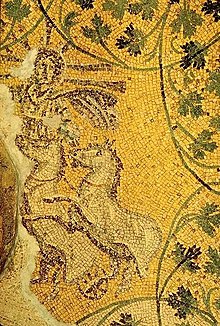This is an old revision of this page, as edited by JL-Bot (talk | contribs) at 00:52, 5 February 2009 (removing non-applicable orphan template). The present address (URL) is a permanent link to this revision, which may differ significantly from the current revision.
Revision as of 00:52, 5 February 2009 by JL-Bot (talk | contribs) (removing non-applicable orphan template)(diff) ← Previous revision | Latest revision (diff) | Newer revision → (diff)
The popularly-named "Tomb of the Julii" (Mausoleum "M") survives in the necropolis beneath St. Peter's Basilica, the so-called "Vatican grotto". The serendipitous discovery near the crypt has a vaulted ceiling bearing a mosaic depicting Helios (Roman Sol Invictus) with an aureole riding in his chariot, within a framing of rinceaux of vine leaves, which are not given their usual pagan Dionysiac reading in this context but are related to the True Vine imagery of Gospel of John 15.1. The mosaic is dated to the late 3rd century to early fourth century A.D. Other mosaics in this tomb depicting Jonah and the whale, the good shepherd carrying a lamb (the kriophoros motif), and fishermen have encouraged its interpretation as a Christian tomb.
See also
References
- Beckwith, John 1979. Early Christian and Byzantine Art (Yale University Press): 19
- Perler, Othmar 1953, Die Mosaiken der Juliergruft im Vatikan (Universitätsverlag): 34-36
External links
This Vatican City–related article is a stub. You can help Misplaced Pages by expanding it. |
This decorative art–related article is a stub. You can help Misplaced Pages by expanding it. |
This Catholic Church–related article is a stub. You can help Misplaced Pages by expanding it. |